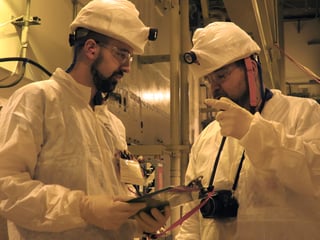I admit it. Since childhood, I have been a fan of the musical film The Sound of Music starring Julie Andrews and Christopher Plummer. As a student of voice from a young age, a song from the musical that I particularly liked was Do-Re-Mi which was used to teach the Von Trapp children how to sing. It begins with the lyrics "Let’s start at the very beginning, a very good place to start." If you think about it, these are wise words to consider when jumping into any activity in life. 
In our labs, we work on many very detailed projects. As our business grows, we are finding that many of those projects require the expertise of several different people and departments across the company. One way we ensure that these projects run as smoothly and as risk free as possible is by utilizing pre-job briefs. Although these are typically held as a final phase of job planning, a pre-job brief is really the beginning of the actual project's work. And, no matter how much planning is put into a project, the proper communication of the plans moving into the execution phase is critical to its success. Moreover, as a company that specializes in process safety as it relates to severe accidents in industry, ensuring that the job is performed without risk to our employees or our customers is especially important. We emphasize working safe as a priority and delivering a quality product as standard, and take the same approach that we recommend to our clients towards safe operations internally.
The Human Performance Handbook issued by our parent company, Westinghouse Electric Company, LLC provides this definition of the term: “A pre-job brief is a planned interactive discussion that occurs just prior to a job, task or prospect and involves all related personnel/team members/stakeholders.”
Although it became common practice as a nuclear industry Human Performance concept, it is really a common sense good business approach applicable to any type of job. A briefing before a work begins helps keep a project on track from the get go. It not only helps ensure that that every person touching the project has a full understanding of the project and their role before work commences and is adequately qualified for the role assigned to them, it provides an opportunity to define the expectations of the work which improves efficiency and provides team members with awareness of the potential areas where things could go wrong in an effort to prevent their occurrence.
Some critical elements to include in a this meeting are:
- Task purpose/scope
- Procedural review
- Roles and responsibilities of team members
- Potential issues/ hazards, and the mitigation plan
- Questions
It should be viewed as a knowledge sharing session to ensure everyone involved is on the same page. In his 2014 article Make Your Pre-job Briefing an Open Dialogue on Safety, David Jackson, Director of Corporate Safety, NAES Corp., suggests making a it a focused dialogue tailored to the task at hand versus a monologue. This cultivates “Intelligent, open conversation among team members.” Brilliant! This approach can also foster teamwork by engaging everyone in the process as well as providing an opportunity for them to share their knowledge where applicable. Jackson also recommends closing the meeting by asking each team member to affirm their understanding of their responsibilities and their ability to complete the work as well as reminding them that if at any time they have a question, they should stop and ask. Again, a GREAT point because it really is better to ask a question than guess and risk putting themselves, their team members or the job itself in danger.
Although the risk of injury in my job as a writer is minimal – I mean I might get a paper cut, strain my eyes or break a nail, I still find that having some sort of discussion about the varied projects I work on detailing the expected outcome before work begins helps me start off in the right direction and work smarter in the process. Hopefully, you can see the value of a pre-job brief in your own work, too.
If you are looking for direction to assure your company is following safe practices contact Zach Hachmeister at 630-887- 5223


